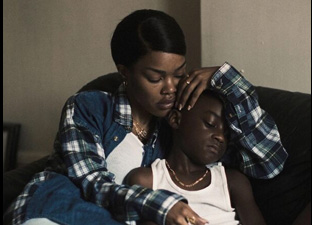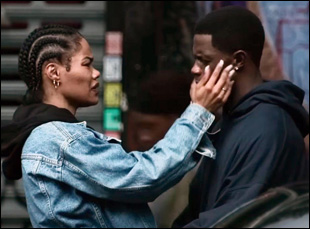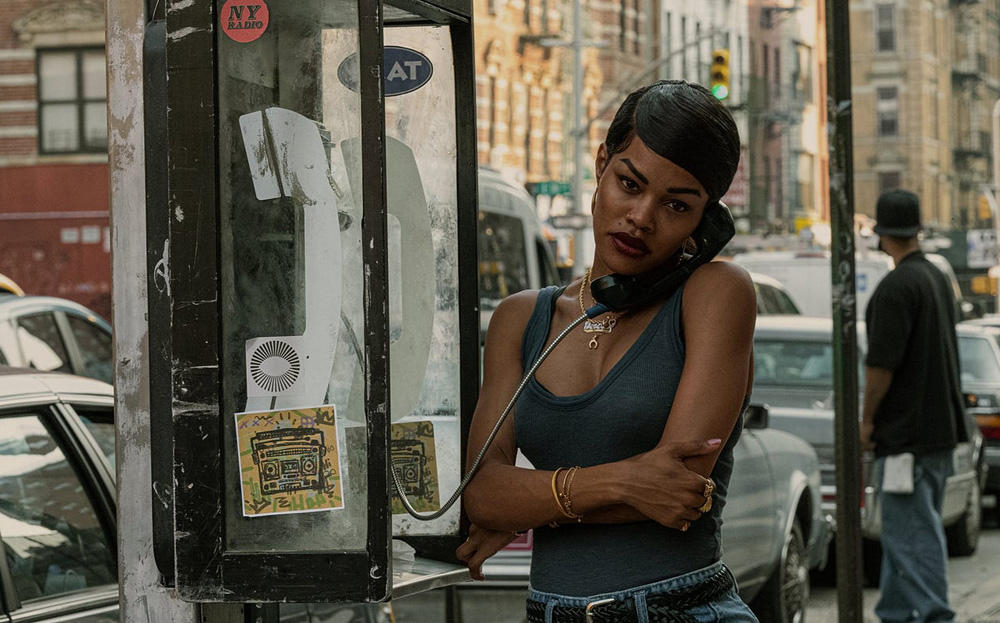Gary Gunn was about to take the subway from Harlem when the notes for the main theme of “A Thousand and One” started to fall into place in his mind. Standing where Inez, the no-nonsense mother at the center of A.V. Rockwell’s magnificent drama, might catch a train herself in the film, the musician and composer had waffled a bit on what direction an introduction could go, still wondering whether a song that could be more pronounced with lyrics might be appropriate or whether something more understated but no less uptempo could do the film’s fierce heroine justice.
“I actually was listening to the rough version that I bounced down on my phone, standing on the platform, listening to it and looking out over 125th Street,” Gunn recalled recently. “And then I gave it to my wife to listen to, and I was like, “Man, this feels so right,” but you never know. I’m like making this thing, and I send it over [to the filmmakers], and I’m like, ‘I hope this resonates because it felt so good.’”
Only the openings of “Shaft,” “Saturday Night Fever” and “Superfly” come to mind when thinking of the entrance music that announces its lead character as rousingly and empathetically as “A Thousand and One” does, feeling both instantly classic and of the city that it’s set in while its buoyancy reflects the survivor of an unforgiving, constant grind who keeps her head up living by her wits to make a life for herself and her young son Terry. You know even before Teyana Taylor shows up to give a haymaker of a performance as Inez that she is a force to be reckoned with, as a drawn-out string section preaches patience while a killer percussive hook kicks in that speaks to her persistence, amounting to a magisterial sonic boom made more resounding by all the various undercurrents lurking underneath the driving beat.
Rockwell lets the music play unbroken over the first five minutes of “A Thousand and One” as Inez leaves Rikers Island to restart her life in Harlem and finds a way to reunite with Terry, with the grace and weight of each step reflected in Gunn’s score and given the runway, his work on the film as a whole is exhilarating, getting at the essence of someone who could be defined by their struggle but instead you feel a clarity of purpose that pulls them through. However, he has shown before he is capable of working on nearly any canvas, instantly giving a sense of the teen prodigy at the heart of Tarell Alvin McCraney’s series “David Makes Man,” inspired like his Oscar-winning script for “Moonlight” by his upbringing in the Liberty City projects of Miami, with its shimmering 15-second theme, and putting as much thought into the various tonal shades in his instrumentation for “Master of Light,” Rosa Ruth Boesten’s documentary portrait of the artist George Anthony Morton as the painter would put into one of his works.
Once famous for his ability to make perfect playlists, Gunn now allows his diverse musical tastes inform his singular compositions, recently recognized by BAFTA as one of its 2023 Breakthrough Artists and showing his considerable range this year not only with “A Thousand and One,” where any of its subtler moments stands as strongly as its robust opening track, but his score for Katja Esson’s “Razing Liberty Square,” in which he subversively played on the sounds typically associated with a heist film to look at longtime residents of affordable housing neighborhoods in Miami that are threatened with displacement by rapacious real estate developers. In the midst of such a momentous year, Gunn graciously took the time out to talk about both the evolution of the “A Thousand and One” score and his own career as he’s moved between producing music and composing, as well as embracing limitations of specific narrative forms to find the music that can transcend them.

A mutual friend/colleague of the director A.V. and I basically put us together [because] he mentioned to me that he thought she would be someone that I should work with and vice versa. I saw A.V.’s short “Feathers,” and I was really impressed by it and we started to talk. We did a smaller project together and then when “A Thousand and One” came up and it was time to actually move forward, they reached out before they started shooting and we started exploring ideas.
The score you hear didn’t really land until much much later in the process after the film really took shape, but it’s really fascinating because I think if I were to go back and think about what those conversations were up front, we got there, even through the different changes and all the exploration [we did] but we were both pretty much on the same page in terms of what we knew this score needed to do. It needed to be timeless. It need to be relevant towards the different areas and the culture within the film, but then it also needed to be very singular and stand out. The way I think of it is, if you were to draw a Venn diagram, you’re trying to achieve all of these little things, and you’re drawing those circles, and you’re trying to hit it in the middle where these things overlap, so what all that exploration allowed us to do was just to figure out what it won’t be. And as the film changes, the picture tends to tell you where things should and shouldn’t go, so it’s an evolving process.
That’s something really worth bringing up because there are a lot of softer moments in this where it seems like you’re really responding to how a scene is lit or the vibrancy that may exist in these more mundane moments where there’s a lot of texture in the score to match what’s on screen. What was that like to work with?
It relates a lot to the score I did for “Master of Light,” which seemed to really resonate with people in different ways and with the director, who when she reached out to me, that’s what she was hammering away about, was the subtlety, but [more so] the dynamics within the subtlety. My background isn’t necessarily in classical music where you write the music and then assign the parts to traditional instruments although I’m comfortable with that as well. I’ve spent so much time sound tweaking [where it’s] almost sound design, and I can get just as inspired off of a single texture as I can from a melody, so I spend a lot of time and energy on trying to figure out how to get the most dynamics out of something minimal. How do you keep things moving and interesting without getting in the way and creating elaborate organic sounds that are very familiar, but you’ve never heard them before? Or maybe you haven’t heard them used in that way. A lot of the decisions I make are informed by classically adjacent things, but things that maybe have been warped in some way or draw from that world but are doing something different. It’s just second nature for me because I put so much time into it in the past and I guess that’s how you build your own personal aesthetic.
You also take into account a real sense of place, which I imagine from your work on “David Makes Man” and “Razing Liberty Square,” where you could get a certain feeling of Miami and South Florida, you might’ve sought out certain sounds for inspiration. Was that the case in “A Thousand and One” where it’s set in your home town?
One of the things that’s always been important is how do you honor the history of film music, meaning do all the things that [traditionally] work, but bring this new cultural perspective in in a very nuanced way, not being very surface with it, like, “Oh, we’re in Miami, we need like lots of 808,” and with “David Makes Man,” Tarrell McCraney, who was the creator of it and wrote “Moonlight,” is so tapped in sonically to that area and we have a lot of musical tastes that overlap, so in some ways, you take the lead of what the director wants to do and then once I have those parameters on me, I can go crazy within that playground. “Razing Liberty Square” was very similar. That opening scene was influenced Henry Mancini’s “Lujon.” It doesn’t sound like that, but [that score] reminds me of Miami and that world and then the sound of those chords [in our score] reminds me that we’re dealing with water and with climate change as something hovering in the background.
Then in ”A Thousand and One,” the sound of the film definitely had to resonate with New York City, not just the cultural urban moments, but also when A.V. references people like Martin Scorsese and you see some of those transitions, the city feels big, so you [need to] get those grand moments and the energy of the city. I’m into so many genres of music that having constraints in the world that the director wants to play in [is helpful because] I can usually find what I love within that space. A.V. had sonic references for the territory that were [already] in my wheelhouse and I was pretty keyed in to how to achieve that sound. A lot of it was re-sampling myself, [and it became a question of] how you get that grit. I don’t want to get too technical, but I also run different processes and things that are very specific to my setup and for [“A Thousand and One”], I ran a very specific signal chain, like a mix bus that’s on the whole score, which gives it that very warm and nuanced feel that feels very specific sonically to that film.
You work on a variety of projects – from art installations to shorts to feature documentaries. Is a narrative feature where you know there’s a closed arc any different to think about?
They’re all just so different because the directors are so different and also the timelines are different. Documentaries, you don’t really get a finished cut of the film until the very, very end, so you’re working alongside the edit and in some cases, it can change drastically because they might take the first scene and then move it towards the end and find a very different story. Then if you do that, the opening music was going to have [a certain] energy, but you’ve got to really keep up with the edit and be really open and very flexible to change. I like to score documentaries the same way I would score a [narrative] film, timed to scenes and with the same intention to storytelling and to be very specific. It can be more difficult to do it because things might change whereas in a narrative like “A Thousand and One,” at some point you do get a picture lock and maybe only small things will change, but the story is what the story is, so you have a much stronger handle early on over the arc.
TV is very different because you’re on such a quick timeline and once the train starts moving, you’re turning things around quickly. You’re also thinking about themes over the entire season, so you might have several themes running that you’re developing in real time and then as the season evolves, those are the ones you start calling back to, so [all these projects are] in the same genre, but they’re very different approaches. And then depending on the director you’re working with, they may have very different working styles.
Just generally, was it much of an adjustment to think of music narratively?
No, I think it’s not. People used to tell me when I was a teenager, before I knew a lot about film music, “Your music sounds like it should be in movies,” and I think it’s because I was drawn to a lot of the music across genres that was very moody or very epic and it’s [always] felt very natural, but it’s an endless learning curve. There’s so much to learn and in film, what’s nice about it is it narrows the scope even more because again, to me, “Well, we can do anything,” and what I hope and feel is that I have a fairly strong aesthetic, but I’m very open genre-wise, so we’re going to explore and I like that the film tells you in a lot of ways what it needs to be, especially once you start getting cuts. You’re looking at it and you may want to do a certain thing and you may get to do some of that, but then also the it’s almost like the film knows what works and what doesn’t, so we’re all just trying to aid it and move it in that direction.
You’re way ahead of the rest of us with projects that are well into the future, but with all these films being released now, what’s this year been like?
It’s just been great, especially in the film and TV space because I was always very deliberate in that space. I was fortunate to have a degree of success working in other spaces, so I didn’t feel pressured to do whatever it takes to [work on a film]. It wasn’t that at all, but more so I want do like-minded projects with people who want to work with me, which I realize now is a huge privilege. The very first short I scored [“The Young and Evil”] was with my best friend from high school, Julian Breece, who actually just wrote “Rustin,” and I did a bunch of his early projects, and that film got into Sundance, so even working with him so early, I was just fortunate that was my introduction into film with Julian.

It was something I always thought about but I didn’t really know how to get in that space. Where I’m from and where I grew up, there were no film composers. To be honest, I didn’t even realize people made music for movies until I was probably a late teenager. The only Black composers I was really aware of were Quincy Jones and then Terrence Blanchard, and it just wasn’t an accessible space necessarily [compared to the] more alternative music spaces where I landed. I knew people in those spaces, but film seemed a little more shut off. Before [“The Young and Evil”], I did get an opportunity to do some music for the show “Sleeper Cell,” just randomly [which] came to me through the kind of music I was making, so I did have interest in going to that space, but I also wanted to do it with quality work.
It’s funny – as much as I’m going to look forward to hearing your work, I’m going to look for your name in the credits since it seems to be such a mark of quality for the project itself. Is there a general criteria you have for the work you take on?
Again, I know it’s a privilege and I hope it continues, but I just enjoy working on really great projects, so it’s things that are held to a high regard and a high artistic creative standard. Especially with documentaries lately, I’ve done more than I set out to do, and it was just because the people calling were doing incredible projects, so I [thought], “Oh, I want to do this, whether or not there’s time and there’s space because the standard is so high,” and they’re things that resonate personally where I feel like I can add value to it. I’ve also been lucky to contribute to stories that resonate with my community, culturally, and they’re not typical stories either, which is pretty amazing to be in that space. Usually the projects that I come on board feel like they’re supposed to happen. I can’t explain it, it’s very strange. And I have an intuition and standards like everyone else, but you generally get a sense I was meant to do it and I needed to do it. I really felt that way on “A Thousand and One.” It’s just a very, very strong urge, so it’s very mystical but it feels that way.
“A Thousand and One” is now available to stream on Prime Video and available on Blu-ray and DVD. “Master of Light” and “David Makes Man” are available to stream on Max. “Razing Liberty Square” continues to play theatrically in the U.S. ahead of a January 24th premiere on Independent Lens and a gallery of Gary Gunn’s installations and interactive work can be found at his personal site.




